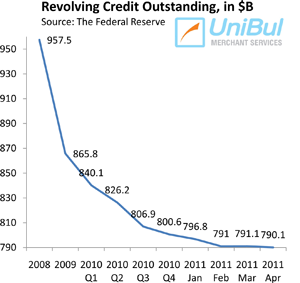U.S. Consumer Credit Card Debt Down to Lowest Level in 7 Years

U.S. consumer credit card debt fell in April, according to the latest report released by the Federal Reserve on Tuesday, which also shows bigger declines in January and February than originally reported. The 2.9 percent increase in outstanding balances that was previously reported for March has been all but erased. All told, the new aggregate total balance of revolving consumer credit in the U.S. is at its lowest level since August 2004.
Non-revolving consumer debt rose again in April, for a ninth consecutive month, the report showed, while total credit increased for a seventh month in a row.
Credit Card Debt Down 1.4% in April
The total outstanding amount of revolving credit, a category comprised almost exclusively of credit card balances, fell in April by 1.4 percent, or $1 billion, bringing the total down to $790.1 billion, the lowest level in almost seven years. Revolving credit has been falling continually since the fall of Lehman Brothers in September 2008, with only two monthly exceptions: in December of last year and this past March.
Overall, since August 2008, the month before the financial meltdown began, the total amount of revolving credit in the U.S. has fallen by $183.5 billion, from $973.6 billion to $ 790.1 billion, a drop of 18.8 percent. On average, each U.S. family with outstanding credit card debt — 54 million by the Fed’s count — has reduced its burden by $3,398 for the period.
Overall Consumer Credit Up 3.1%
 The non-revolving portion of the U.S. consumer debt, made up of auto loans, student loans and loans for mobile homes, boats and trailers, but not including loans for home mortgages and other real estate-secured assets, rose for a ninth consecutive month. The Federal Reserve reported a 5.3 percent increase, bringing the total to $1,638.1 billion, up $7.2 billion from March.
The non-revolving portion of the U.S. consumer debt, made up of auto loans, student loans and loans for mobile homes, boats and trailers, but not including loans for home mortgages and other real estate-secured assets, rose for a ninth consecutive month. The Federal Reserve reported a 5.3 percent increase, bringing the total to $1,638.1 billion, up $7.2 billion from March.
On the whole, the total of revolving and non-revolving U.S. consumer credit rose by $6.3 billion, or 3.1 percent, to $2,428.2 billion in April, after increasing by a revised $4.8 billion in March. It was its seventh consecutive month of increase.
Consumer Credit Card Delinquencies Continue to Fall
As the overall volume of outstanding credit card balances has fallen to record-low levels, other key indicators have been following similar trajectories. Both credit card delinquencies and charge-offs are at near record-lows and continue to fall.
The charge-off rate on credit cards issued by U.S. banks fell by 0.19 percent in April on a month-over-month basis, to 7.16 percent, according to Moody’s Credit Card Index. Charge-offs (or defaults) are delinquent credit card balances that issuers no longer expect to be repaid and write off their books as losses, usually at 180 days after receiving the latest payment on the account. The charge-off rate reached its highest level of 11.5 percent in August 2009.
Credit card delinquencies continue to fall as well, indicating that the charge-off rate has not yet reached its bottom. According to Moody’s, the rate of credit card payments late by 60 days or more decreased for the 18th consecutive month in April, to 3.53 percent. The early-stage delinquency rate — measuring the ratio of payments late by 30 – 59 days — fell to 0.88 percent, the lowest level recorded since Moody’s began tracking early-stage delinquencies at the beginning of 2000.
Credit Card Takeaway
The strong 2.9 percent increase in revolving credit the Fed originally reported for March led me to believe that the post-Lehman credit card deleveraging trend may be nearing its end. Now that the data have been revised downward and the April figures have shown a further decline, the deleveraging process is clearly still well under way.
The exceptionally high rate at which Americans are repaying the principal amount of their credit card debt also indicates that U.S. consumers have resolved on keeping outstanding balances under control. After reaching an all-time high of 21.77 percent in March, that rate dropped to 20.02 percent in April, which is still a level not seen since the peak of the housing boom of 2006 – 2007 according to Moody’s.


